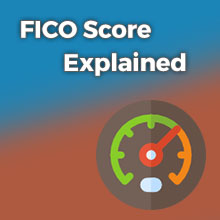Credit Score, FICO Score Explained

So… What’s a credit score?
Your credit score is a number based on the information in your credit file that shows lenders how likely you are to repay a loan.
The higher your score is the less risk you represent and the more desirable you are to have as a client.
Your credit score is also called a FICO score.
This score not only determines if you qualify for a loan but it also determines what interest rate that you will pay if you get a loan.
Your credit score changes as you change the way that you handle your bills and credit accounts.
If you pay off your credit accounts and start paying your accounts on time each month your credit score will improve and so will your credit worthiness in the eyes of lenders.
A credit score is based on certain information found in your credit history from your credit report.
Payment history makes up the majority of the credit score.

Information regarding payments on credit cards, finance companies, store or retail accounts, installment loans and mortgages.
Payment histories also include public record information such as information on bankruptcies, judgments, wage garnishments, collection accounts, and the number of both past due and paid as agreed accounts.
Other pieces of information that paint your credit score picture include the overall amount of money that you owe and the number of as well as the types of open accounts that you have.
This includes the balances and credit limits of your accounts.
Also taken into account is the length of your credit history, how long the accounts have been open and how long has it been since they have seen activity.
Inquiries from other companies are also noted.
If you apply for and are turned down for credit too many times could raise a red flag to another lender.

All of this information makes up your credit score and the financial picture that lenders look at.
Late payments will definitely lower your score but getting back on track with timely and consistent payments even through a Debt Management Program will only improve your score.
Creditors look at your current score as it applies now.
FICO Scoring System
O = Open Account (paid in full every billing cycle i.e. Am Ex)
R = Revolving Account (payments differ from month to month as balance owed Fluctuates i.e. credit card,)
I = Installment Account (fixed payment and fixed number of payments i.e. car loan)
0 = approved
1 = paid as agreed
2 = 30+ days late
3 = 60+ days late
4 = 90+ days late
5 = 120+ days late or in collection
7 = making regular payments under wage earners plan
8 = repossession
9 = charge off
J = joint account
I = individual account
U = undesignated
A = authorized user
T = terminated
M = maker
C = co-maker (co-signer)
B = on behalf of another person
S = shared




